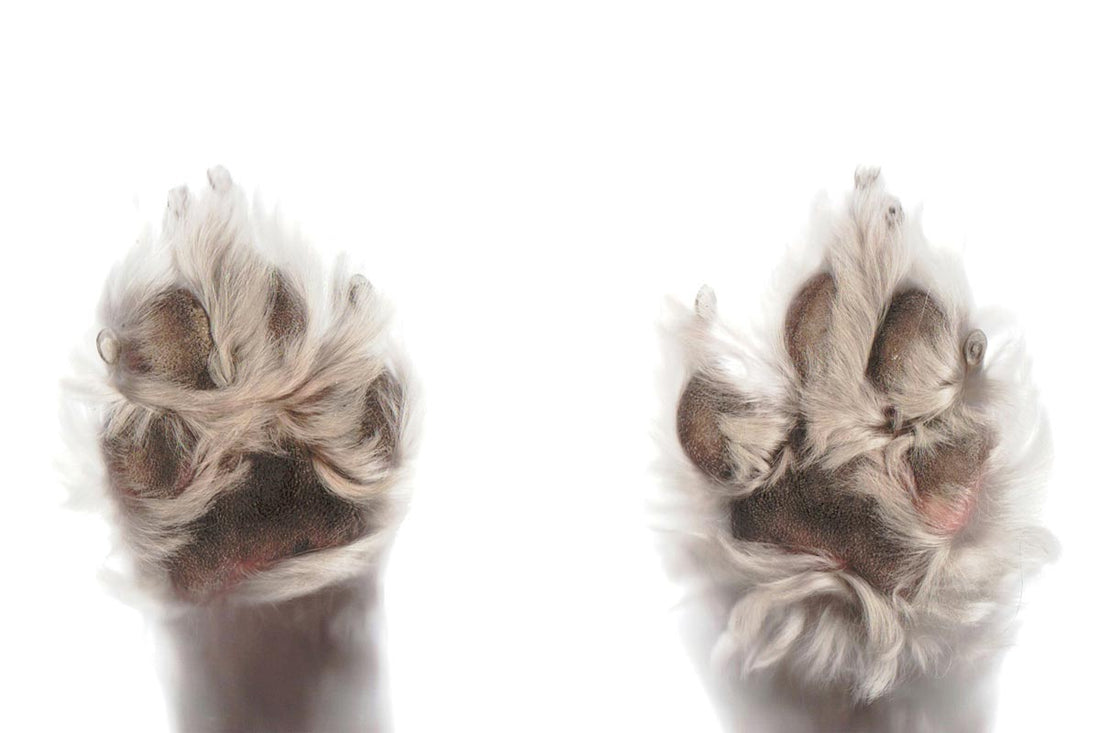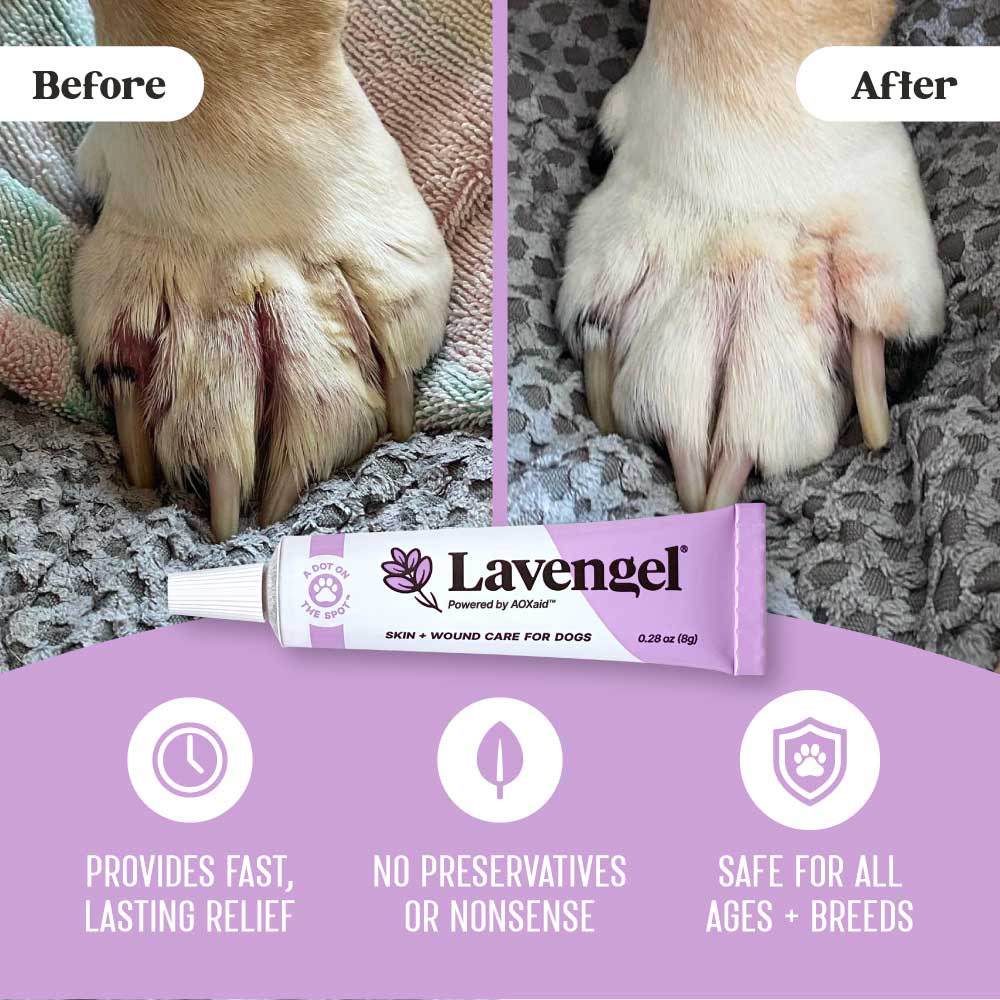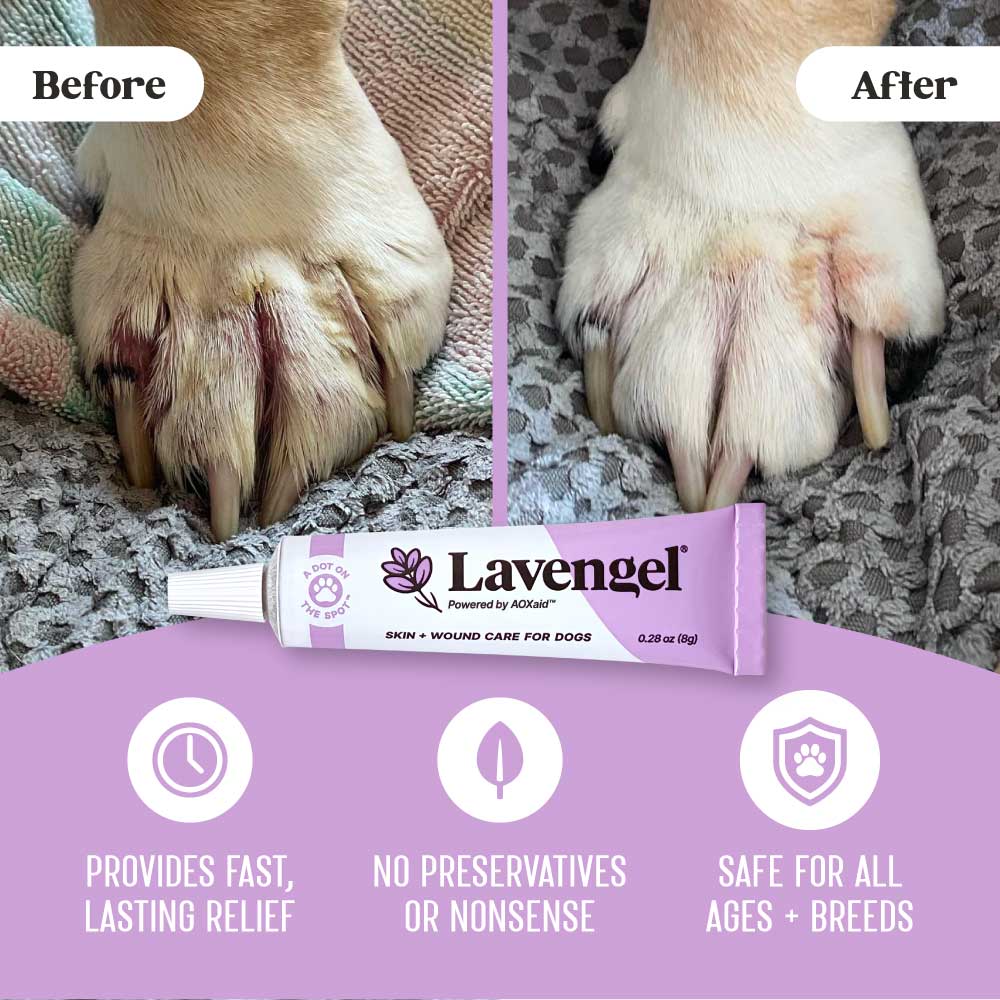by Zack Wright
Ah, the serenade of a dog obsessively licking its foot. Too bad it's a song that gets stuck on repeat this time of year.
Winter time means more time spent indoors, where we become more attuned to the habits of our furry roommates. A few topics related to dogs' skin that take up a lot of Google searches in the winter time involve itchy, irritated dog paws, excessive paw licking (everyone's favorite sound to hear at 2 AM), and paw yeast infections.
As we'll see ahead, much of these issues can be connected to dry skin, along with seasonal and environmental allergies.
Why Does My Dog Lick His/Her Paws So Much During Winter?
Dogs lick their paws and feet for a variety of reasons, but, aside from keeping them clean, the chief aim is usually to soothe some form of discomfort.
As logic would have it, constant licking means something about that area is really bothering them. Unfortunately, the more they lick, the more damage they end up doing, and problems such as fur loss and hot spots can crop up.
For the curious, we've compiled an intriguing list of the top 10 causes of dog paw licking on our valuable Paw Licking Resource.
But for this post, we'll review the reasons most pertinent to winter time.

Dry Skin and Paw Pads
As mentioned in our previous post on managing your dog's dry skin during the winter months, cold winter air has a drying effect on dogs' outermost layer of skin - also known as the stratum corneum. This is further compounded by the warm, dry air in our homes.
An arid stratum corneum can be an itchy sensation in itself, but dry skin is also weakened skin, which becomes brittle, flaky, and more susceptible to damage. This in turn allows irritants to get into the skin more easily.
It's much like the paint, sealant, or weather-stripping that keeps air and (bad) moisture out of your house. Once it gets too dry, it cracks and loses its ability to seal out the elements properly. As the elements get in, the damage begins to spread, and mold and mildew (i.e., infection) can get established.
This very principle applies to the fur, paws, and pads, too. They are part of the skin, after all.

Dog Paws, Salt, and De-icing Chemicals
If you live in an area that is blessed with frozen water chunks falling from the sky, you are probably familiar with the salt and chemicals that are spread to get rid of it on roads, sidewalks, and parking lots.
Turns out, this stuff is about as bad for dog paws as it is for ice (and the paint on your car). Over time, it can severely dry out your dog's pads and the skin between them.
Here are a few things to keep in mind regarding road salt and chemicals, in a conveniently bulleted format:
- Avoid walking your dog on surfaces covered in salt or de-icing chemicals for long stretches.
- Wipe their paws off once they're back inside. This is generally a good idea after walks in general.
- Invest in booties for your dog for winter walks or romping in the snow. Arctic-bred barkers are exempt from this, but keep an eye on their pads if there's salt around.
- Check out this list of reputable dog footwear brands from our previous post if you're in the mood for a bit of online shopping.
Seasonal and Environmental Allergies
Allergies are possibly the most common reason for a dog's excessive + obsessive licking of the paws and feet.

Photo: Paw of Australian Shepherd exhibiting significant allergic reaction with atopic dermatitis and general redness
Examples of Allergens that Affect Dogs
Allergens are simply things that your dog's immune system deems a threat and raises a defense (inflammation) against. While there is not always a clear answer as to WHY a dog's immune system dislikes a certain something, it's this reaction that brings the itching and redness. When this inflammation manifests in the skin, it is referred to as atopic dermatitis, or atopy, and it creates a powerful itching sensation.
Some common and not-so-common allergens are:
- Pollen
- Mold
- Dust mites
- Dander (dead skin cells) - even human dander
- Chemicals, such as cleaning supplies
- Cosmetics
- Parasites, including flea saliva
- Certain food ingredients (see our Complete Guide to Canine Food Allergies for more on that)
What Do Skin Allergies in Dog Paws Look Like?
Though not in all cases, canine skin allergies typically bring about itching, inflammation, and a general redness of the paws and other specific areas of the skin, such as the belly, armpits, groin, and face. Again, this skin condition is referred to as atopic dermatitis, atopy, or allergy dermatitis.
If you see your dog constantly chewing at their feet on both their front and hind legs, and these exhibit a general redness, there's a strong chance that an allergic reaction of some sort is to blame. Parasites such as mites or fleas are another possibility.

Photo: Red, raw spot on side of paw pad, likely caused by excessive licking from allergies; via r/William_Dafhoe on Reddit
Paw Injuries or Unseen Debris
It's easy to miss objects that are covered in ice or snow. Small wounds on the paws or debris lodged between a dog's pads or toes - including pieces of ice - can irritate their feet.
If you see your dog spending an inordinate amount of time tasting his/her foot, take a closer look. There may be a small cut, pebble, or piece of bark hiding in there.
Bacterial and Yeast Infections in Dog Paws
Like allergies, infections are a year-round hazard. In fact, allergies and infections (both bacterial and fungal) often go hand-in-hand - some might say paw-in-paw.
The allergies bring the itching, licking, and scratching, which breaks the skin barrier and allows the microbes to enter and establish an infection. On top of this, recall that dry skin is weakened skin that is more easily damaged.
Bacterial Infections, or Pyoderma
Pyoderma is a fancy word for "pus in the skin," and it is used to describe any form of bacterial infection in the skin. While we won't go into great detail here, you can learn all you want about bacterial skin infections in our Canine Pyoderma Resource.
Nearly all cases of pyoderma in dogs are caused by a single species of bacteria called Staphylococcus pseudintermedius, which is a cousin to Staphylococcus aureus that affects humans. These bacteria naturally live on the skin and cause no harm whatsoever until they begin to grow out of control.
Pyoderma can be very itchy and irritating, causing a self-perpetuating problem that spreads and grows worse as a dog tries to relieve the itch by biting, licking, rubbing, and scratching. Untreated bacterial infections can lead to very serious, even systemic problems.
As we'll mention again later, our product Lavengel® is excellent for canine pyoderma and carries a patent for its ability to inhibit and kill Staph bacteria, including Staph pseudintermedius.
For those feeling extra-nerdy, check out our resident researcher Tasha's article on Staph bacteria and biofilms.

Photo: Pitbull mix paw with inflammation and infection between pads due to excessive licking and chewing; via Reddit
Yeast Infections, or Malassezia
Similar to pyoderma, the vast majority of yeast infections and yeast dermatitis are caused by a single species of fungus called Malassezia pachydermatis. In fact, yeast infections are commonly secondary to pyoderma, and it is believed that there is a symbiotic relationship between Malassezia and Staph pseudintermedius.
Malassezia yeast infections are incredibly itchy and can be hard to get rid of, especially if there is indeed an underlying bacterial infection. Yeast infections can begin with the paws and spread across the body, causing fur loss, bad odor, and hardened, dark colored patches of skin.
As with pyoderma and other skin conditions, you can learn a lot more about yeast infections of the paws, skin, and ears in our Canine Yeast Infections Resource.
What Do Bacterial and Yeast Infections in Dog Paws Look Like?
Pyoderma tends to manifest in forms that carry pus or discharge: red sores, pustules around hair follicles, or round, red lesions with a flaky edge. These areas will likely be sensitive and painful as the infection sets in.
Malassezia infections typically exhibit a general redness or pinkness to the skin, with progressing fur loss, severe itching, and a musty odor. As yeast dermatitis (infection of the skin) spreads, scaly, greasy skin crusts may form, and the skin may begin to look hardened, leathery, and darkened (hyperpigmentation) in some places.

Photo: Red dog paw with inflammation and probable bacterial infection after constant licking and chewing at atopy; via r/Glitter_Mountain on Reddit
It's important at this point to note these things:
- Not all cases will exhibit these exact signs.
- The only way to truly know the type of infection is via a veterinary diagnosis. (See each respective Resource page for how they do this.)
- It is very possible for both types of infection to be present at the same time.
- If a yeast infection is present, vets will often prescribe treatment against bacterial infection as well.
- These infections seldom, if ever, go away on their own.
Treating, Caring For, and Preventing Dry or Irritated Dog Paws + Pads During Winter
Reducing dryness, excessive paw licking, and the risk of paw infections during the winter boils down to keeping your dog's skin hydrated and healthy, keeping their allergies in check, and treating any infections early.
How to Keep Your Dog's Skin Hydrated and Healthy
If you read our previous post, we love you for that, and you'll likely notice many of these same preventative tips.
Diet and Supplementation
A healthy skin and coat - which flows all the way down to the feet - begins from within.
A balanced diet with plenty of Omega-3 fatty acids is a great foundation for keeping your dog's skin from drying out. These fatty acids are often supplemented with chews and treats, and there is absolutely no shortage of them on the internet.

Humidifiers
Indoor air is typically drier air, which contributes to dry skin for everyone. Consider having a humidifier in the rooms where your dogs spend the most time.
Keep Those Paws Clean and Clear of Salt
Salty and chemical-covered pavement is the enemy of your dog's tootsies. Keep them off of such surfaces for prolonged periods, protect their feet with footwear, and clean their paws after walks in the elements.
Bathe, But Don't Over-bathe Your Dog
As with humans, regular bathing is great idea. Be sure to wash between your dog's toes and pads, as these are the spots where bacteria and yeast love to dwell.
However, bathing your dog too much can dry their skin out further. Over-bathing strips their skin of the natural oils produced in the hair follicles, which are necessary to keep a healthy moisture barrier.
Make Sure Your Dog is Dry After Getting Wet
On the flip side, moisture that gets trapped in pockets under fur, collars, and crevices can be detrimental, in that it creates a prime location for microbes to grow and hot spots to develop. No need to over do it, but make sure your furry bark machine is dry after baths or playing in the snow and that collars, harnesses, and jackets aren't restricting proper air flow.

Dog Lotions, Paw Balms, and Lavengel®
Apply a bit of extra nourishment to those paws and pads with a balm, lotion, or ointment for dogs (emphasis on for dogs). Some good ingredients to look out for are aloe, glycerin, beeswax, and shea butter.
Alternatively, Lavengel® can also serve as a good moisturizer for dry skin spots and paw pads. Its natural lavender oil and special form of Vitamin E provide a soothing hydrogel-like barrier that keeps moisture in and relieves itch and irritation. Not only that, but it can also help heal damaged skin and stop infections.
Keeping Your Dog's Allergies in Check
Allergies are unique to each dog, and each dog has different sensitivities to different allergens. Some breeds tend to have more skin problems and allergies than others - Pitbull terriers, Yorkshire terriers, bulldogs, Labrador Retrievers, and Golden Retrievers to name a few.
The tricky part is isolating and finding the specific allergens that trigger a reaction. This is usually a trial and error process, especially with food allergies.
If exposure to an allergen can be removed or reduced, the reaction and itching should begin subside. In cases where this is not realistic, your veterinarian may prescribe a regular antihistamine regimen of oral or injected medications to reduce the immune response and mitigate the irritation.
If allergies are limited to certain areas, Lavengel® can be of use in relieving irritation and keeping the allergy dermatitis from worsening. In fact, we have many customers report that they keep our gel on hand for the very reason of helping keep the seasonal itchy spots from spreading or turning into the dreaded hot spots.

Photo: Example of hot spot (acute moist dermatitis) on dog paw, via r/Spirited_Ad9924 on Reddit
Treat Any Paw Infections Promptly
Allergies in themselves are bad enough, but half of the reason they must be mitigated is to prevent the scratched, chewed, and damaged skin from becoming infected. Bacteria and yeast on the skin are always looking for an opportunity to multiply and take over.
Infections, both bacterial and fungal, are best met with early and forcefully. The longer an infection lingers, the harder it is to get rid of, as the microbes become more resistant.
In fact, Staph pseudintermedius and other bacteria have an amazing, diabolical ability to develop resistance mechanisms to antibiotic treatment. One such form of resistance is called a bacterial biofilm, which is an organic "forcefield" that protects not only the bacteria, but also other microbes seeking refuge, like yeast.
How Are Bacterial and Fungal Paw Infections Treated?
Localized skin infections in dogs are typically treated topically with prescription antibiotic and antifungal ointments and creams. It's important to note that, as two separate kinds of organisms, bacteria and yeast are affected by different types of ingredients.
For bacteria, antibiotics with ingredients such as neomycin, nystatin, mupirocin, clindamycin, or gentamicin are generally prescribed, along with an Elizabethan collar (cone) as these products are not safe if ingested by your dog.
For yeast and fungi, antifungals with terbinafine, or "azole" ingredients such as clotrimazole, ketoconazole, miconazole, or fluconazole are prescribed. Likewise, these products should not be licked or ingested by your barker.
In addition, there's Lavengel®. Not only does it inhibit the growth of bacteria and fungi, but it also soothes itching, helps moderate skin inflammation, and aids in skin healing. On top of these things, it's safe for dogs to lick, and doesn't require a prescription.

Photo: Before and after of English bulldog paw with pyoderma infection soothed with Lavengel®; see the whole story on our Customer Stories page
Final Thoughts
Winter time means cold, dry outdoor air and warm, dry indoor air, both of which sap the moisture out of our dogs' skin. This means their skin, paws, and pads are more susceptible to irritation from injury, allergies, and infections.
Add to that the salt and de-icing chemicals used on pavement, and you've got a perfect recipe for dry paws and pads.
Here's a recap of what you can do to reduce paw licking and prevent paw irritations during the cold months:
- Support their skin and coat health with Omega-3 fatty acids.
- Keep salt and de-icing chemicals off of their paws.
- Consider booties for your dog's feet, especially if they aren't used to frigid conditions.
- Monitor your dog's allergies. A regular antihistamine from the vet may be a lifesaver in helping mitigate them; plus, Lavengel® can be quite useful in alleviating irritating spots.
- Monitor their paw licking. If it exceeds the norm, or seems focused on a single area, take a look!
- Take care of any cuts, dry paw pads, or patches of dermatitis quickly, preferably with - you guessed it - Lavengel®.
- If you suspect an infection, consult with your veterinarian. And yes, even for these, our gel is here if you need it.
For more info on the mysteries of why dogs lick their tootsies so much, see our Canine Paw Licking Resource.
Stay toasty out there!









